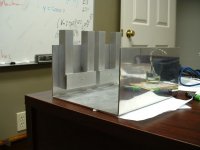Day one of "The Polish"
Day one:
Yes, that's my reflection in the front panel of the amp. I'm up to 2000 grit wet sanding, but can still see some swirl marks from the random orbital sander, so I may take it back to 800 Grit tomorrow. The stacks are going to be hard to polish, might have to call on the Dremel for that.
Day one:
Yes, that's my reflection in the front panel of the amp. I'm up to 2000 grit wet sanding, but can still see some swirl marks from the random orbital sander, so I may take it back to 800 Grit tomorrow. The stacks are going to be hard to polish, might have to call on the Dremel for that.
Attachments
MantramAudio said:
Yes, that is an LM1875, and yes I have a whiteboard. Doesn't every engineer's office?
what are you planning on doing to those poor little guys?
travis said:
what are you planning on doing to those poor little guys?
The LM1875's will be powering some small full range speakers attached to my XM Satellite receiver.
The white board is used to write stuff on.😉
What's wrong with LM1875's?
i don`t think u need aleph sized heatsinks for a lm1875. the heat dissipated doesn`t even come close to the aleph...
hacknet said:i don`t think u need aleph sized heatsinks for a lm1875. the heat dissipated doesn`t even come close to the aleph...
These sinks are miniscule compared to alephs. And they are internal, so they don't show up, except for the stacks that will protrude through the top of the amp.
This may be a ridiculously stupid question, but why are people so persistent about cooling these chips? The max they'll dissipate is, lets say, 50 watts. I know that I used a huge heatsink for my amp, but that's because I got it for free. Why are you guys trying so hard to cool the ICs? My sink NEVER gets warm and it's an 1/8 of the size of the pics above. Is there an advantage to this? Law of diminishing returns...? Thanks for any replies.
Which is why my convection system is designed for 60 watts sink.It probably will never be used to max capacity , but its there if i need it.
ron
ron
So you're just using convection cooling instead of a standard sink? Is that because it's more space efficient? Why would you use convection cooling? What are the advantages/disadvantages?
Doovieman said:So you're just using convection cooling instead of a standard sink? Is that because it's more space efficient? Why would you use convection cooling? What are the advantages/disadvantages?
For me, it's just because I was inspired by the clean look of Peter's amp.
Also, thhis is a hobby, and I think the one off-ness of the hobby is a nice feature. If we all built Aleph clones, and sat around and talked about our Aleph clones all day, I'd get a little bored.
As far as the heat sink on the shiny amp above goes, I have no idea how many watts it will dissipate, and don;t even know how to calculate it. I was just loking for something different, yet inspired by Peter's beautiful amp that started this post.
Third, cooler is better, right?
Basic physics.
There are 3 methods of heat transfer,conduction,radiation and convection.Of these convection (if designed properly) is the most efficent.A round vent is the most effective as the hot gasses rise in the center and allow a greater conduction of the heat transfer from the center of the vent(rising hot gasses) from the inner walls of the vent(shorter distance). In my design i use augmented convection cooling in which i put a tight fitting spring on the inside of the tube.This makes a vortex action in which the hot rising gasses are swirled towards the inner walls of the vent tube and allow a greater heat transfer of the rising gasses/inner wall of the vent tube.
ron
There are 3 methods of heat transfer,conduction,radiation and convection.Of these convection (if designed properly) is the most efficent.A round vent is the most effective as the hot gasses rise in the center and allow a greater conduction of the heat transfer from the center of the vent(rising hot gasses) from the inner walls of the vent(shorter distance). In my design i use augmented convection cooling in which i put a tight fitting spring on the inside of the tube.This makes a vortex action in which the hot rising gasses are swirled towards the inner walls of the vent tube and allow a greater heat transfer of the rising gasses/inner wall of the vent tube.
ron
Re: Basic physics.
Ron, do you have a site with any pictures of your designs?
ron clarke said:In my design i use augmented convection cooling in which i put a tight fitting spring on the inside of the tube.This makes a vortex action in which the hot rising gasses are swirled towards the inner walls of the vent tube and allow a greater heat transfer of the rising gasses/inner wall of the vent tube.
ron
Ron, do you have a site with any pictures of your designs?
- Status
- Not open for further replies.
- Home
- Amplifiers
- Chip Amps
- Convection cooling in a GC amp

